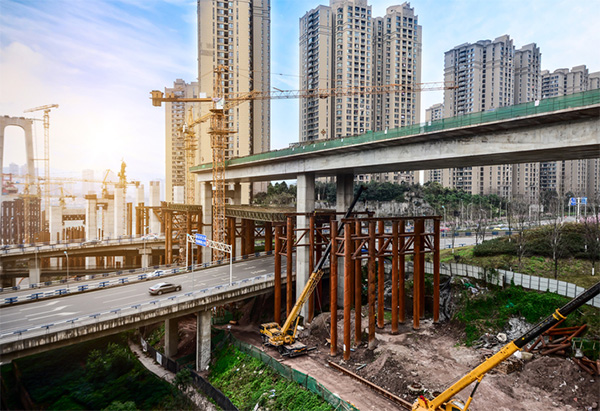Trump Tweet raises the call for $2 trillion infrastructure package as part of coronavirus funding

With the myriad moving parts related to the ongoing coronavirus, or COVID-19 pandemic, it has seemed that a future plan relating to a new long-term federal surface transportation authorization would remain where it has seemingly been for a while, on the back burner.
Well, based on a recent Tweet issued by President Trump, one could get the impression that sentiment towards a federal infrastructure could be gaining traction.
The Tweet reads as follows: “With interest rates for the United States being at ZERO, this is the time to do our decades long awaited Infrastructure Bill. It should be VERY BIG & BOLD, Two Trillion Dollars, and be focused solely on jobs and rebuilding the once great infrastructure of our Country! Phase 4.”
With interest rates for the United States being at ZERO, this is the time to do our decades long awaited Infrastructure Bill. It should be VERY BIG & BOLD, Two Trillion Dollars, and be focused solely on jobs and rebuilding the once great infrastructure of our Country! Phase 4
— Donald J. Trump (@realDonaldTrump) March 31, 2020
The $2 trillion tally is nothing to sneeze at, to be sure, but another thing to be sure of is that, coronavirus pandemic aside, we are amid, arguably, the most dysfunctional political times maybe ever. Agree or disagree, if you like, it is merely an observation.
That said it will be a bumpy ride to this goal to make it across the finish line, in an election year no less.
One reason for that stems from how there are clearly many different definitions of infrastructure. In our freight transportation and logistics world, infrastructure is clearly focused on things like highways, roads, interstates, ports, terminals, and airports. But other definitions take a look at infrastructure in the form of public drinking water systems, hospital capacity, and rural broadband upgrades, which are cornerstones of a House Democrat vision of future infrastructure initiatives, according to a recent report in The Hill.
The report noted that House Democrats maintain this focus would include job gains, which would be welcome, given the recent staggering numbers of Americans filing for unemployment benefits.
One of the first people I reached out to when I learned about this development was Randy Mullett, principal of Mullett Strategies, a consulting practice focused on helping clients navigate the intricacies of Washington, DC in the areas of trucking, freight, sustainability, security, and safety, and longtime Government Relations and Public Affairs official for Con-way and XPO Logistics.
“We have a lot of unmet infrastructure needs that could be addressed in a large infrastructure package but, while the president is talking roads and bridges some Democrat leaders are talking more about internet access, the electrical grid, and other public utilities (water and sewer),” Mullett explained. “All may be necessary, and worthy, but highways and bridges benefit all communities and spread the dollars and jobs more broadly than some of the other proposals. Transportation projects also generate revenue for the federal treasury with increased gas/fuel taxes. Finally, an improved transportation system will lead to economic growth and efficiency.”
Mullett, as usual, made some really good points in raising the key points and drivers for a federal infrastructure focus.
And Elaine Nesse, executive director of the Washington, D.C.-based Coalition for America's Gateways and Trade Corridors, said that the opportunity to rebuild our economy and our nation’s infrastructure through a stimulus proposal is a bipartisan win-win.
“The COVID-19 pandemic has illustrated just how important our nation’s supply chain infrastructure is to our day-to-day lives,” she said. “In order to support a rebounding economy, significant resources must be invested in our nation’s key freight gateways and trade corridors. Not only do freight projects put people to work at all levels – from project design through construction – but the benefits of these projects support jobs and a higher standard of living for the future.”
It is also worth noting that before the coronavirus took hold, infrastructure was, at least getting some attention—on both sides of the aisle—in Washington, D.C., especially coming out of the House Transportation & Infrastructure Committee.
Now, despite the President’s Tweet, things truly feel like they are in a prolonged holding pattern, when it comes to infrastructure (and many other things, too, of course). With things so uncertain, it is really difficult to gauge when we will see meaningful movement on a new long-term federal surface transportation authorization. That is not ideal, but will we get there eventually.

Article Topics
Latest in Logistics
UPS announces CFO Newman to leave company, effective June 1 Preliminary April North American Class 8 net orders are mixed Senators take a close look at Amazon with Warehouse Worker Protection Act Despite American political environment, global geopolitical risks could be easing Maryland DOT: $1.9 billion and up to four years to rebuild bridge sunk near Baltimore port April Services PMI contracts after 15 months of growth, reports ISM 2023 industrial big-box leasing activity heads down but remains on a steady path, notes CBRE report More LogisticsAbout the Author
Subscribe to Logistics Management Magazine

Find out what the world's most innovative companies are doing to improve productivity in their plants and distribution centers.
Start your FREE subscription today.
May 2024 Logistics Management

Latest Resources














